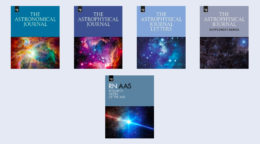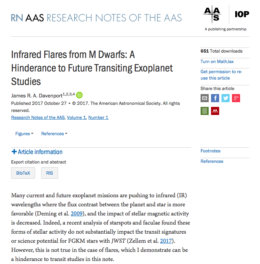Null results — research outcomes that show what doesn’t work, rather than what does — are a crucial part of science. It’s imperative that these results are shared widely, so that researchers can learn from each others’ experiences instead of unnecessarily repeating work.
Unfortunately, null results are often difficult to publish in traditional venues, as they represent the steady march of science in the background rather than exciting new discoveries. And null results aren’t alone — there are a number of other types of scientific research that are of interest to the astronomical community, and yet they cannot easily be shared, archived, or cited.A Home for Non-Traditional Communications
Enter Research Notes of the American Astronomical Society (RNAAS) — a new and unique journal that just joined the AAS journal family this week. RNAAS provides a means of sharing with the astronomical community work that may not fit into traditional publication outlets. There are many types of submissions that could be appropriate for RNAAS, such as:
- Null results
- Timely reports of observations (like the spectrum of a supernova)
- Brief observations (like the discovery of a single exoplanet or contributions to the monitoring of a variable source)
- Work in progress or projects of limited scope (like the results of a summer undergraduate research project)
Why Publish a Research Note?
RNAAS is a non-peer-reviewed, non-edited journal that is moderated by one of the AAS journals’ lead editors, Dr. Chris Lintott (University of Oxford). Communications published in RNAAS are brief — they are limited to <1000 words, with space for one table or figure. Research Notes have the benefit of being:
- Searchable and citable
Since Research Notes are indexed by ADS, this ensures that researchers can easily find work that might otherwise have gone unshared. And since Research Notes are assigned a DOI, this means that information from Research Notes can be referenced in future publications. - Archived for perpetuity
Publishing data and results in RNAAS — part of the AAS suite of journals and hosted alongside them by Institute of Physics Publishing — prevents the risk that this less formal information is unintentionally lost to the community as a result of institution changes, outdated websites, etc. (a common problem in academia!). - Quick to publish
Need to notify the community of something in a hurry, and don’t have time to wait for a traditional journal’s publication process? Research Notes are typically available online within three business days of when they are received. - Free to access (and to publish!)
RNAAS is not behind a paywall, so Research Notes can be read by anyone and do not require an institutional or personal subscription to AAS journals to access. What’s more, the AAS is currently suspending charges for all submissions to RNAAS, so publishing a Research Note costs nothing at this time.
Find Out More and Submit
Intrigued? You can go see for yourself what people are submitting to RNAAS.
Convinced? We look forward to receiving your submission to RNAAS!
Citation
Ethan T. Vishniac and Chris Lintott 2017 Res. Notes AAS 1 1. doi:10.3847/2515-5172/aa93da



1 Comment
Pingback: One Year of Research Notes of the AAS